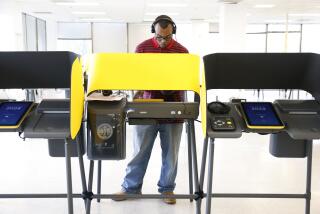Campaign 2012: All voters matter, but Ohio voters matter the most
If you live in Ohio, Barack Obama and Mitt Romney are giving you a lot of love. But if you reside in California or Alabama, you may feel neglected and ignored by the candidates for president. Like parents in a big, noisy family, all their attention goes to the troublesome kids, not the compliant, quiet ones.
There has never been much doubt that states such as California, New York, Massachusetts and Washington would give their electoral votes to the president, and no doubt that Romney could depend on states such as Alabama, South Carolina, Texas and South Dakota to be solidly in his camp. All but about 10 states lined up months ago for one candidate or the other. Now it looks as if the number of states still up for grabs has dropped to seven.
As a result, there is really not a national campaign going on. All the effort and money for many weeks has been focused on voters in the swing states. Since, under the U.S. Constitution, the electoral vote, not the popular vote, determines who will sit in the Oval Office, and since the winner in each state takes all of that state’s electoral votes (with Nebraska and Maine being the two outliers where there is a possibility of splitting the vote), a presidential election really amounts to 50 distinct elections.
PHOTOS: Top of the Ticket cartoons
With as many as 43 of those 50 elections already decided, the real campaign is happening in just the remaining seven. That means any regional concerns folks in California or Alabama might have can be ignored by the contenders, who do all of their pandering in Ohio, Florida, Virginia, Iowa and the few other places that have the potential to pick the winner.
Some people blame the electoral college system for this imbalance, but there is more to it than that. The electoral college has been part of presidential politics as long as Americans have been choosing presidents, but only in much more recent times have candidates determined they can ignore most of the country and concentrate on just a few states. What has altered the dynamic is the vastly greater amount of information campaigns now have to work with.
It began in the 1930s, when the first serious polls were conducted. Until then, it was difficult to know with any great precision who was voting and why. In subsequent decades, polls became far more accurate and frequent. This has allowed campaigns to know with greater certainty how they are doing at any moment in a campaign and where their best opportunities for finding more votes may lie.
But even more than polls, the science of marketing has gotten so sophisticated that polls are sometimes not even necessary in the search for likely supporters. In the Internet Age, mountains of data are available about all of us and it can be sifted to pinpoint how any individual is going to vote.
If you are a single female, living in Pasadena, working at a university, driving a Prius, shopping at Whole Foods, watching “The Daily Show,” reading books by Anne Tyler, listening to music by k.d. lang and vacationing in Rome, the Romney campaign does not need to waste time trying to get your vote. If you are a male, living in Tuscaloosa, managing an auto parts store, attending a Foursquare Gospel church twice a week and listening to Toby Keith in your Dodge Ram pickup as you drive into the countryside for a day of deer hunting, the Obama campaign is not likely to spend a cent on you.
It turns out most of us are the predictable sum of the things we do, drive, read, buy, eat and otherwise consume. Political marketers can fairly accurately say how we will vote because of that. And so the less predictable citizens among us in the least predictable states are seen as impact players, while the rest of us merely sit on the sidelines until we can cast our predictable votes.
More to Read
A cure for the common opinion
Get thought-provoking perspectives with our weekly newsletter.
You may occasionally receive promotional content from the Los Angeles Times.







